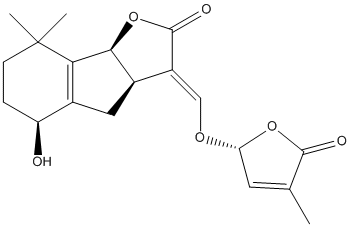Strigol
General
Type : Plant hormone || Strigolactone || Strigolactone receptors ligand || Natural || Inden
Chemical_Nomenclature : (3E,3aR,5S,8bS)-5-hydroxy-8,8-dimethyl-3-[[(2R)-4-methyl-5-oxo-2H-furan-2-yl]oxymethylidene]-3a,4,5,6,7,8b-hexahydroindeno[1,2-b]furan-2-one
Canonical SMILES : CC1=CC(OC1=O)OC=C2C3CC4=C(C3OC2=O)C(CCC4O)(C)C
InChI : InChI=1S\/C19H22O6\/c1-9-6-14(24-17(9)21)23-8-12-10-7-11-13(20)4-5-19(2,3)15(11)16(10)25-18(12)22\/h6,8,10,13-14,16,20H,4-5,7H2,1-3H3\/b12-8+\/t10-,13+,14-,16+\/m1\/s1
InChIKey : VOFXXOPWCBSPAA-KCNJUGRMSA-N
Other name(s) : (+)-strigol, CHEBI:9290, (3E,3aR,5S,8bS)-5-hydroxy-8,8-dimethyl-3-({[(2R)-4-methyl-5-oxo-2,5-dihydrofuran-2-yl]oxy}methylene)-3,3a,4,5,6,7,8,8b-octahydro-2H-indeno[1,2-b]furan-2-one, AC1NQYET

Target
Families : RsbQ-like
References (6)
| Title : Strigol induces germination of the facultative parasitic plant Phtheirospermum japonicum in the absence of nitrate ions - Ogawa_2022_Plant.Signal.Behav_17_2114647 |
| Author(s) : Ogawa S , Shirasu K |
| Ref : Plant Signal Behav , 17 :2114647 , 2022 |
| Abstract : Ogawa_2022_Plant.Signal.Behav_17_2114647 |
| ESTHER : Ogawa_2022_Plant.Signal.Behav_17_2114647 |
| PubMedSearch : Ogawa_2022_Plant.Signal.Behav_17_2114647 |
| PubMedID: 35993137 |
| Title : Strigolactones are chemoattractants for host tropism in Orobanchaceae parasitic plants - Ogawa_2022_Nat.Commun_13_4653 |
| Author(s) : Ogawa S , Cui S , White ARF , Nelson DC , Yoshida S , Shirasu K |
| Ref : Nat Commun , 13 :4653 , 2022 |
| Abstract : Ogawa_2022_Nat.Commun_13_4653 |
| ESTHER : Ogawa_2022_Nat.Commun_13_4653 |
| PubMedSearch : Ogawa_2022_Nat.Commun_13_4653 |
| PubMedID: 35970835 |
| Title : A new UHPLC-MS\/MS method for the direct determination of strigolactones in root exudates and extracts - Rial_2019_Phytochem.Anal_30_110 |
| Author(s) : Rial C , Varela RM , Molinillo JMG , Lopez-Raez JA , Macias FA |
| Ref : Phytochem Anal , 30 :110 , 2019 |
| Abstract : Rial_2019_Phytochem.Anal_30_110 |
| ESTHER : Rial_2019_Phytochem.Anal_30_110 |
| PubMedSearch : Rial_2019_Phytochem.Anal_30_110 |
| PubMedID: 30280444 |
| Title : The preparation of synthetic analogues of strigol - Johnson_1981_J.Chem.Soc.Perkin.1__1734 |
| Author(s) : Johnson AW , Gowda G , Wassanali A , Knox J , Monaco S , Razawi Z , Roseberry G |
| Ref : J Chem Soc Perkin 1 :1734 , 1981 |
| Abstract : Johnson_1981_J.Chem.Soc.Perkin.1__1734 |
| ESTHER : Johnson_1981_J.Chem.Soc.Perkin.1__1734 |
| PubMedSearch : Johnson_1981_J.Chem.Soc.Perkin.1__1734 |
| PubMedID: |
| Title : Germination stimulants .2. Structure of strigol - potent seed-germination stimulant for witchweed (Striga-Lutea lour) - Cook_1972_J.Am.Chem.Soc_94_6198 |
| Author(s) : Cook CE , Coggon P , Mcphail AT , Wall ME , Whichard LP , Egley GH , Luhan PA |
| Ref : Journal of the American Chemical Society , 94 :6198 , 1972 |
| Abstract : Cook_1972_J.Am.Chem.Soc_94_6198 |
| ESTHER : Cook_1972_J.Am.Chem.Soc_94_6198 |
| PubMedSearch : Cook_1972_J.Am.Chem.Soc_94_6198 |
| PubMedID: |
| Title : Germination of Witchweed (Striga lutea Lour.): Isolation and Properties of a Potent Stimulant - Cook_1966_Science_154_1189 |
| Author(s) : Cook CE , Whichard LP , Turner B , Wall ME , Egley GH |
| Ref : Science , 154 :1189 , 1966 |
| Abstract : Cook_1966_Science_154_1189 |
| ESTHER : Cook_1966_Science_154_1189 |
| PubMedSearch : Cook_1966_Science_154_1189 |
| PubMedID: 17780042 |